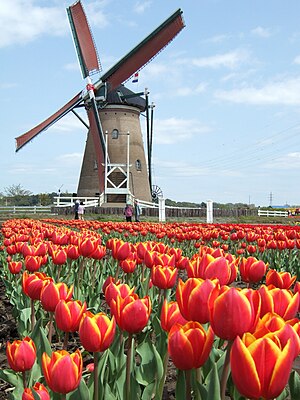Windmill
A windmill is a type of working engine. It converts the wind's energy into rotational energy. To do this it uses vanes called sails or blades.[1][2]
The energy made by windmills can be used in many ways. These include grinding grain or spices, pumping water and sawing wood. Modern wind power machines are used to create electricity. These are called wind turbines by engineers or wind mills by the average person. Before modern times, windmills were most commonly used to grind grain into flour for making bread. The windmill has been in history for many years.
History
An organ powered by a windwheel was written about in the 2nd century AD by the Greek engineer Hero. It could have been the first machine in history that used wind power.[3][4] Vertical axle windmills were used in eastern Persia (Sistar) by 60 AD. Horizontal axle windmills were invented in Northwestern Europe in the 1180s.[5] This is the type often used today.
Early history
The first windmills had long vertical shafts with rectangle shaped blades. They existed in Persia in the 9th century.[6] There is a story about a windmill and the second caliph Umar (634\644 AD). It is not known if this is a true story.[7] These windmills were made of six to twelve sails. The sails were covered in reed matting or cloth. They were very different from European versions. A similar type of vertical shaft windmill with rectangle blades can also be found in 13th century China. They were used for irrigation.
How they work
The blades or sails of the windmill are turned by the wind. Gears and cogs makes the drive shaft inside the windmill turn. In a windmill used for making flour, this turns the grinding stones. As the stones turn, they crush the wheat (or other grain) between them. In a windmill used for pumping water, turning the drive shaft moves a piston. The piston can suck up and push out water as it moves up and down. In a windmill used for generating power, the drive shaft is connected to many gears. This increases the speed and is used to turn a generator to make electricity.
Windmills in culture and literature
Miguel de Cervantes' book Don Quixote de La Mancha has an important scene in which Don Quixote attacks windmills. He thinks that they are violent giants. Because of this, La Mancha and its windmills are famous. This is also the origin of the phrase "tilting at windmills". It means an act of uselessness. "Moulin Rouge" translated directly from French, and means Red Windmill.
Gallery
Windmills of Western Siberia, taken by Prokudin-Gorskii, c. 1910
The windmills of Kinderdijk, the Netherlands
Double wind wheel and common Aermotor wind wheel in Texas
A modern wind turbine in Sweden.
Windmill Media
The windmills at Kinderdijk in the village of Kinderdijk, Netherlands is a UNESCO World Heritage Site
Windmill in the Azores islands, Portugal.
Tower mills in Consuegra, Spain
Two smock mills with a stage in Greetsiel, Germany
5-sail Holgate windmill in York, England
Related pages
Footnotes
- ↑ "Mill definition". Thefreedictionary.com. Retrieved 2013-08-15.
- ↑ "Windmill definition stating that a windmill is a mill or machine operated by the wind". Merriam-webster.com. 2012-08-31. Retrieved 2013-08-15.
- ↑ A.G. Drachmann, "Heron's Windmill", Centaurus, 7 (1961), pp. 145-151
- ↑ Dietrich Lohrmann, "Von der östlichen zur westlichen Windmühle", Archiv für Kulturgeschichte, Vol. 77, Issue 1 (1995), pp.1-30 (10f.)
- ↑ Dietrich Lohrmann, "Von der östlichen zur westlichen Windmühle", Archiv für Kulturgeschichte, Vol. 77, Issue 1 (1995), pp.1-30 (18ff.)
- ↑ Ahmad al-Hassan, Donald Hill: Islamic Technology. An illustrated history, 1986, Cambridge University Press, p.54f. ISBN 0-521-42239-6
- ↑ Dietrich Lohrmann, "Von der östlichen zur westlichen Windmühle", Archiv für Kulturgeschichte, Vol. 77, Issue 1 (1995), pp.1-30 (8)
Further reading
- A.G. Drachmann: "Heron's Windmill," Centaurus, 7 (1961), pp. 145–151
- Hugh Pembroke Vowles: "An Enquiry into Origins of the Windmill", Journal of the Newcomen Society, Vol. 11 (1930-31)
Other website
| Definitions from Wiktionary | |
| Media from Commons | |
| News stories from Wikinews | |
| Quotations from Wikiquote | |
| Source texts from Wikisource | |
| Textbooks from Wikibooks | |
| Learning resources from Wikiversity | |
- Windmills at Windmill World
- The International Molinological Society (TIMS)
- All About The American Water Pumping Windmill
- Norfolk Mills
- Britannica
- 1st English Post Windmill, Virginia
- Poldaw Windpumps Archived 2007-04-21 at the Wayback Machine, intended principally for applications in developing countries.
History links
- Windmillers' Gazette
- History of the Traditional American Farm Windmill
- windmillworld: history
- American Wind Power Center - An American water pumping windmill museum in Lubbock, Texas USA.
- Shattuck Windmill Museum[dead link] Thirty-nine water pumping windmills used on the plains; in Shattuck, Oklahoma
- Illinois Windmills—history and archives for the Dutch windmills in the state.
- Theory
